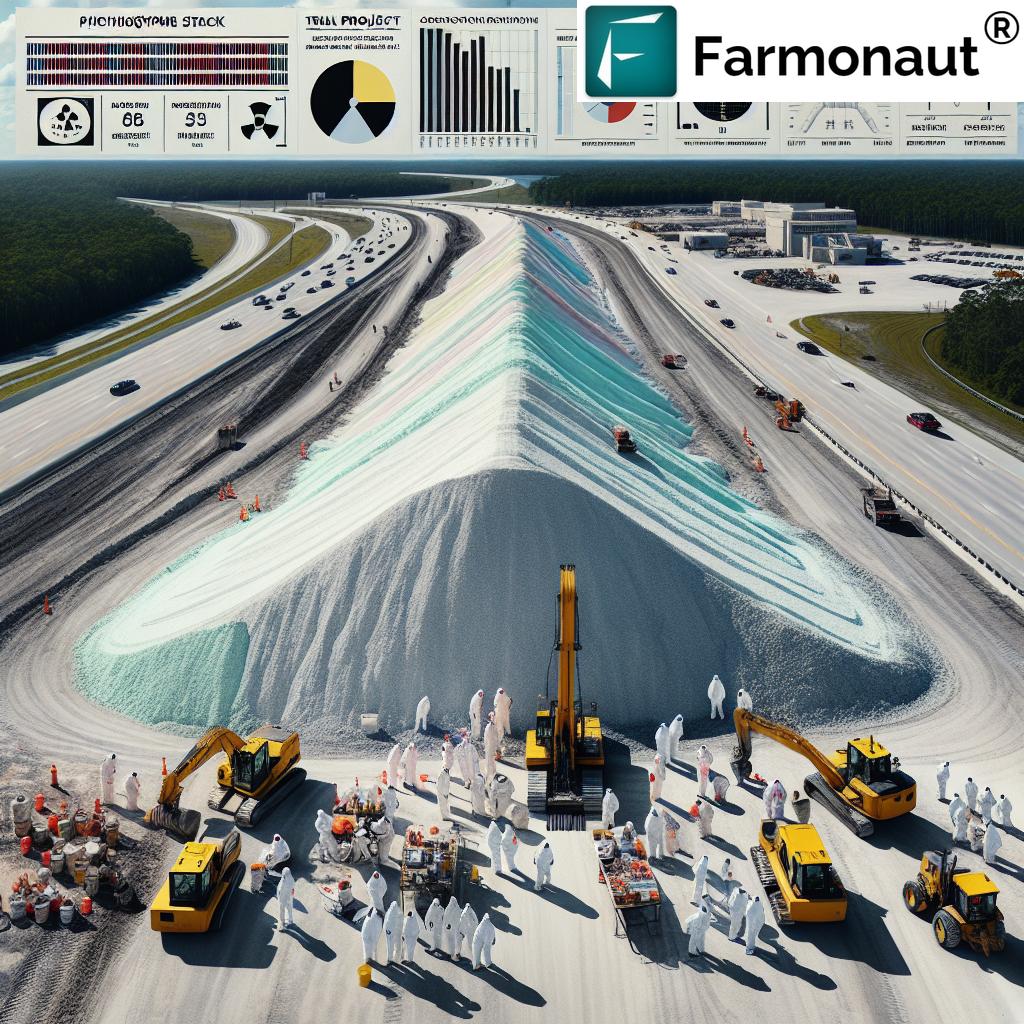Sustainable Roadways or Radioactive Risk? Florida’s Phosphogypsum Road Experiment Sparks Environmental Debate
“Florida’s phosphogypsum road experiment uses a byproduct containing radium to create a private test road over 18 months.”
In the heart of Polk County, Florida, a groundbreaking experiment is underway that could potentially revolutionize road construction while simultaneously addressing a longstanding waste management issue. The Mosaic Company, a leading phosphate producer, has embarked on a controversial project to build a road using phosphogypsum (PG), a radioactive byproduct of phosphate fertilizer production. This innovative approach has ignited a fierce debate among environmentalists, scientists, and local residents, raising questions about the balance between sustainable waste management and potential health risks.
Understanding Phosphogypsum: From Waste to Resource
Phosphogypsum is a byproduct of the process used to create phosphoric acid, a key component in fertilizer production. For decades, this material has been considered waste, piling up in massive stacks across Florida’s landscape. However, with over 1 billion tons of PG in Florida alone, researchers and industry leaders have been searching for ways to repurpose this abundant material.
The use of phosphogypsum in road construction presents a unique opportunity to transform a problematic waste product into a valuable resource. By incorporating PG into road base materials, we could potentially reduce the environmental impact of phosphate waste management while creating more sustainable road building materials.

The Polk County Experiment: A Closer Look
The Mosaic Company’s test road near Mulberry, Florida, represents a small-scale pilot project aimed at evaluating the feasibility and safety of using phosphogypsum in road construction. This private road, not open to public traffic, will be monitored over an 18-month period to assess its performance and environmental impact.
Key aspects of the experiment include:
- A road base mixture containing phosphogypsum and other materials
- A 4-inch thick asphalt pavement covering the PG-based road base
- Continuous monitoring for potential environmental effects
- Evaluation of PG’s effectiveness as a road building material
This project aligns with Florida’s recent legislative push to explore alternative uses for phosphogypsum. In 2023, Governor Ron DeSantis signed House Bill 1191, which encouraged research into PG as a building material and permitted its use in roadways under certain conditions.
The Environmental Debate: Weighing Risks and Benefits
“Phosphogypsum, a waste from phosphoric acid production, contains radioactive materials and is being tested as a sustainable road base.”
The use of radioactive materials in roadways has understandably raised concerns among environmental groups and local residents. The primary issues revolve around the potential for radiation exposure and the release of radon gas, a known carcinogen produced by the decay of radium in phosphogypsum.
However, proponents of the project argue that the benefits of repurposing phosphogypsum could outweigh the risks if proper safety measures are implemented. Let’s examine the key points on both sides of the debate:
Potential Benefits:
- Reduction of phosphogypsum waste stockpiles
- Creation of a sustainable alternative for road construction materials
- Potential cost savings in road building and waste management
- Decreased environmental impact of phosphate mining and processing
Potential Risks:
- Radiation exposure to construction workers and nearby residents
- Radon gas emissions from road surfaces
- Potential contamination of soil and groundwater
- Long-term health effects on communities near PG roads
To address these concerns, rigorous scientific analysis and continuous monitoring are essential components of the Polk County experiment. The EPA’s approval of the project came after a thorough risk assessment, which determined that the proposed use of phosphogypsum in this controlled setting was “as protective of human health as placement in a stack.”
Regulatory Oversight and Public Opinion
The EPA’s involvement in approving and overseeing the phosphogypsum road experiment underscores the importance of strict regulatory compliance in projects involving potentially hazardous materials. The agency’s decision to green-light the pilot project came after a period of public comment, during which many citizens expressed opposition to the use of PG in public roads.
While the current experiment is limited to a private road, the possibility of expanding phosphogypsum use to public roadways in the future has sparked intense debate. Critics argue that more extensive studies are needed to fully understand the long-term impacts of PG roads on human health and the environment.
The Mosaic Company, for its part, has emphasized the importance of trusting the scientific process and welcomes rigorous testing. In a statement, they expressed their belief in the principles of a circular economy, where materials once considered waste can be repurposed beneficially.
The Role of Technology in Environmental Monitoring
As we explore innovative solutions like phosphogypsum roads, advanced monitoring technologies play a crucial role in ensuring environmental safety. At Farmonaut, we understand the importance of data-driven decision-making in agriculture and environmental management. While our focus is on precision agriculture, the principles of using satellite imagery and AI for monitoring can be applied to various environmental projects.
For instance, our carbon footprinting technology could potentially be adapted to monitor emissions from phosphogypsum roads, providing real-time data on environmental impact. Similarly, our expertise in blockchain-based traceability could be valuable in tracking the movement and use of phosphogypsum in road construction, ensuring transparency and accountability throughout the process.

The Future of Phosphogypsum in Road Construction
The outcome of the Polk County experiment could have far-reaching implications for both the phosphate industry and road construction practices. If successful, this project could pave the way for a new era of sustainable road building, transforming a radioactive waste product into a valuable resource.
However, several crucial questions remain to be answered:
- How will phosphogypsum roads perform over extended periods?
- What are the long-term environmental and health impacts of widespread PG use in roadways?
- How can we balance the benefits of waste reduction with potential radiation risks?
- What regulatory frameworks need to be in place to ensure safe implementation?
As we await the results of this groundbreaking study, it’s clear that the debate surrounding phosphogypsum use in road construction will continue to evolve. The intersection of waste management, environmental protection, and infrastructure development presents both challenges and opportunities for innovation.
Comparative Analysis: Phosphogypsum Road Construction
| Aspect | Potential Benefits | Potential Risks |
|---|---|---|
| Environmental Impact | Reduction of waste stockpiles; decreased mining impact | Possible soil and water contamination |
| Sustainability | Repurposing of waste material; resource conservation | Long-term effects on ecosystems uncertain |
| Cost-effectiveness | Potential savings in road construction and waste management | Increased costs for safety measures and monitoring |
| Radiation Concerns | Controlled use may limit exposure compared to stockpiles | Risk of radiation exposure to workers and public |
| Long-term Durability | Possible improved road longevity and strength | Uncertain performance over extended periods |
| Waste Management | Significant reduction in phosphogypsum stockpiles | Potential for improper handling or disposal |
| Public Health | Reduced exposure if properly managed compared to open stacks | Concerns over radon gas emissions and long-term health effects |
| Regulatory Compliance | Opportunity for developing new, sustainable regulations | Challenges in ensuring consistent safety standards |
The Role of Technology in Environmental Management
As we delve deeper into innovative solutions like phosphogypsum roads, the importance of advanced monitoring and management technologies becomes increasingly apparent. At Farmonaut, we specialize in leveraging cutting-edge technology for agricultural and environmental applications. While our primary focus is on precision agriculture, many of our tools and methodologies could be adapted to support projects like the phosphogypsum road experiment.
For instance, our large-scale farm management solutions utilize satellite imagery and AI to monitor vast areas efficiently. Similar technology could be employed to track the environmental impact of phosphogypsum roads over large geographical areas, providing real-time data on soil health, vegetation changes, and potential contamination.
Additionally, our fleet management tools, designed for agricultural machinery, could be adapted to monitor construction equipment and vehicles involved in phosphogypsum road projects. This would ensure efficient resource utilization and help maintain strict safety protocols during the construction and maintenance phases.
Environmental Monitoring and Risk Assessment
One of the most critical aspects of the phosphogypsum road experiment is the continuous monitoring of environmental impacts. This includes tracking potential radiation levels, soil and water quality, and air emissions, particularly radon gas. Advanced monitoring systems are essential to ensure public safety and gather valuable data for future decision-making.
Farmonaut’s expertise in satellite-based monitoring and AI-driven analysis could potentially contribute to these efforts. Our technology, which is typically used for crop plantation and forest advisory services, could be adapted to monitor vegetation health around phosphogypsum roads, providing early indicators of any adverse environmental effects.
Economic Implications and Sustainable Development
The potential economic benefits of using phosphogypsum in road construction are significant. Not only could it provide a cost-effective alternative to traditional road building materials, but it could also create new job opportunities in the phosphate industry and related sectors. However, these economic advantages must be carefully weighed against potential long-term environmental and health costs.
From a sustainable development perspective, the phosphogypsum road experiment aligns with principles of circular economy and waste reduction. By finding productive uses for industrial byproducts, we can potentially reduce the environmental footprint of multiple industries simultaneously.
Public Engagement and Transparency
As with any project involving potential environmental risks, public engagement and transparency are crucial. The phosphogypsum road experiment has already sparked significant public debate, highlighting the need for clear, accessible information and open dialogue between industry, regulators, and local communities.
Technologies like those developed by Farmonaut for agricultural traceability could play a role in enhancing transparency in phosphogypsum road projects. By providing real-time, verifiable data on material sourcing, construction processes, and environmental monitoring, we can help build public trust and facilitate informed decision-making.
The Global Context: International Perspectives on Phosphogypsum Use
While the Polk County experiment is groundbreaking in the United States, it’s important to note that other countries have been exploring the use of phosphogypsum in construction for years. Understanding these international experiences can provide valuable insights as we evaluate the potential of PG roads in Florida and beyond.
For example, some European countries have successfully used phosphogypsum in road construction and other applications for decades, under strict regulatory frameworks. These case studies could offer important lessons on long-term safety, environmental impact, and best practices for implementation.
The Future of Sustainable Infrastructure
The phosphogypsum road experiment in Florida represents just one facet of a broader global shift towards more sustainable infrastructure solutions. As we grapple with the challenges of climate change, resource depletion, and waste management, innovative approaches like this will become increasingly important.
At Farmonaut, we’re committed to supporting sustainable development through technology-driven solutions. While our focus is on agriculture, the principles of data-driven decision-making, efficient resource management, and environmental monitoring that we apply in our work are equally relevant to projects like the phosphogypsum road experiment.
Conclusion: A Balancing Act
The phosphogypsum road experiment in Polk County, Florida, represents a fascinating intersection of waste management, environmental protection, and infrastructure development. As we await the results of this 18-month study, it’s clear that the use of phosphogypsum in road construction has the potential to address significant waste management challenges while potentially providing a sustainable alternative for road building materials.
However, the concerns about radiation exposure and long-term environmental impacts cannot be dismissed. Rigorous scientific analysis, continuous monitoring, and transparent communication will be essential as we evaluate the viability of this innovative approach.
As technology continues to evolve, companies like Farmonaut are developing tools that could play a crucial role in monitoring and managing projects like these. From satellite-based environmental monitoring to blockchain-enabled traceability, these technologies offer new ways to ensure safety, transparency, and efficiency in complex environmental projects.
Ultimately, the success of initiatives like the phosphogypsum road experiment will depend on our ability to balance innovation with caution, economic benefits with environmental protection, and scientific progress with public safety. As we move forward, it’s crucial that we remain open to new solutions while maintaining a commitment to rigorous testing, regulatory oversight, and public engagement.
The road ahead may be paved with phosphogypsum, but it’s up to us to ensure that it leads to a more sustainable and environmentally responsible future.
FAQ Section
- What is phosphogypsum?
Phosphogypsum is a byproduct of phosphoric acid production, containing small amounts of radioactive materials like radium. - Is phosphogypsum radioactive?
Yes, phosphogypsum contains low levels of naturally occurring radioactive materials, primarily radium. - How is phosphogypsum being used in road construction?
In the Florida experiment, phosphogypsum is being used as part of the road base material, covered by a layer of asphalt. - What are the potential benefits of using phosphogypsum in roads?
Benefits include reducing waste stockpiles, creating a sustainable road building material, and potentially lowering construction costs. - What are the main concerns about phosphogypsum roads?
The primary concerns are potential radiation exposure, radon gas emissions, and long-term environmental impacts. - How is the safety of phosphogypsum roads being evaluated?
The Florida experiment involves an 18-month study to assess environmental impacts, durability, and safety of the phosphogypsum road. - Are phosphogypsum roads legal in the United States?
Currently, the use of phosphogypsum in roads is limited to approved experimental projects like the one in Florida. - How does the EPA regulate phosphogypsum use?
The EPA oversees the use of phosphogypsum and must approve projects involving its use outside of traditional storage stacks. - Could phosphogypsum roads become common in the future?
If the current experiments prove successful and safe, it’s possible that phosphogypsum could be more widely used in road construction in the future, subject to regulatory approval. - How can technology help monitor the safety of phosphogypsum roads?
Advanced technologies like satellite imaging, AI-driven analysis, and blockchain-based traceability can help monitor environmental impacts and ensure safety standards are maintained.
Explore Farmonaut’s Innovative Agricultural Solutions
While Farmonaut specializes in agricultural technology, our commitment to sustainability and innovation aligns with the spirit of projects like the phosphogypsum road experiment. Discover how our cutting-edge solutions can revolutionize your farming practices:
Earn With Farmonaut: Join our Affiliate Program
Earn 20% recurring commission with Farmonaut’s affiliate program by sharing your promo code and helping farmers save 10%. Onboard 10 Elite farmers monthly to earn a minimum of $148,000 annually—start now and grow your income!
Farmonaut Subscriptions
For developers interested in integrating our powerful agricultural data into their own applications, check out our API and API Developer Docs.
















